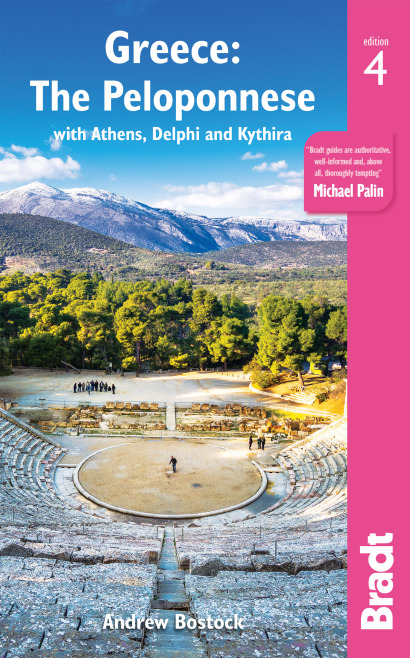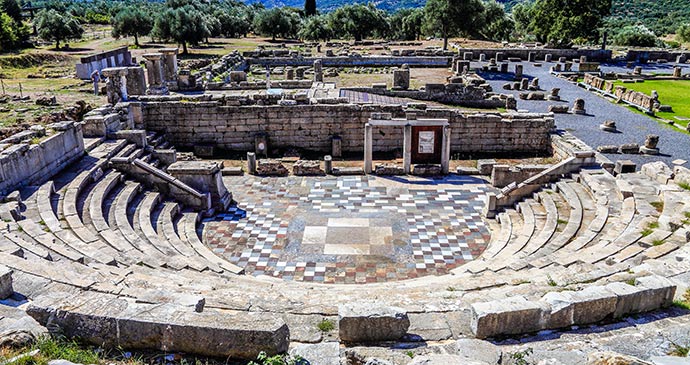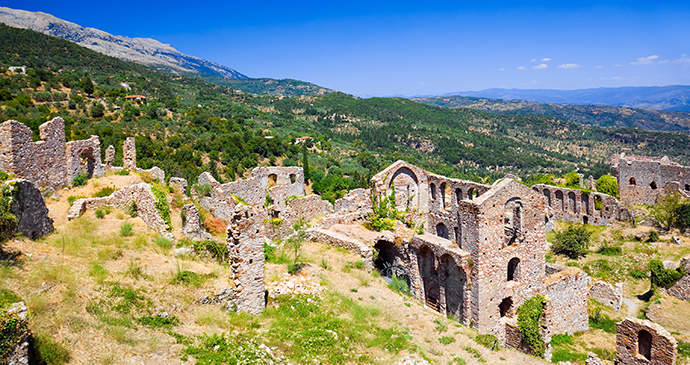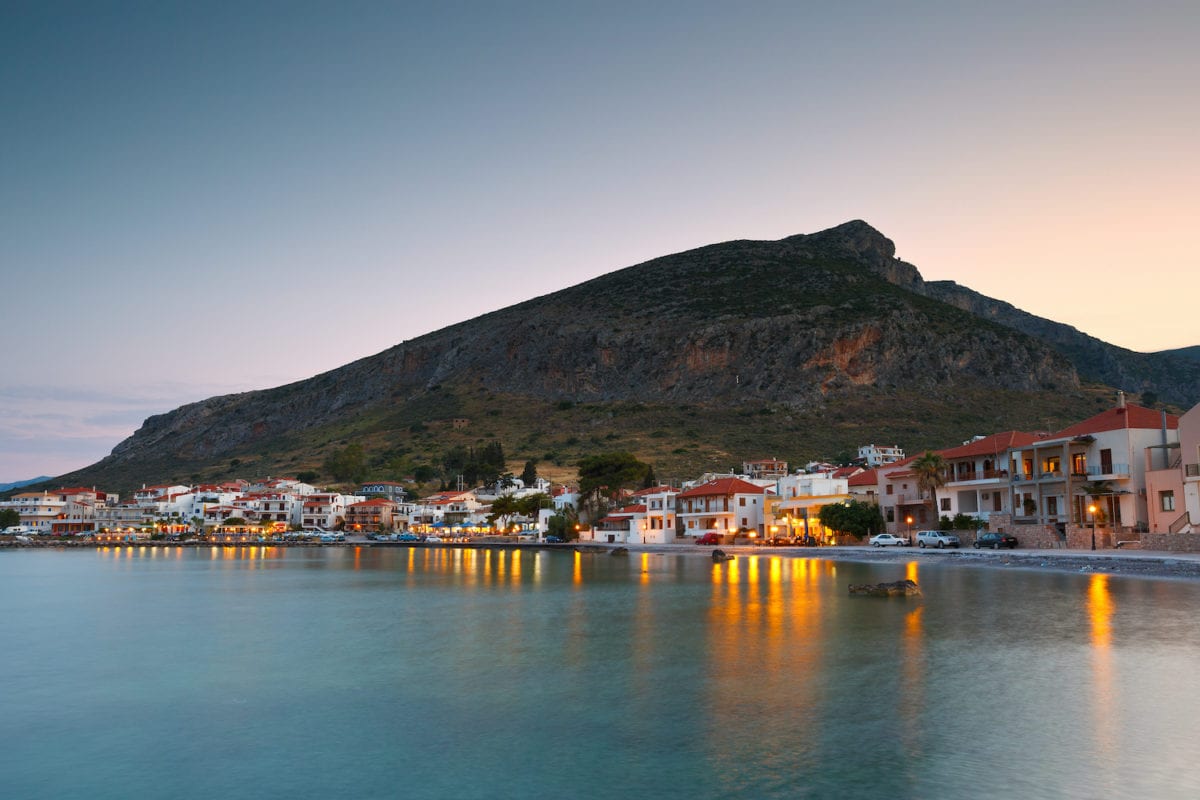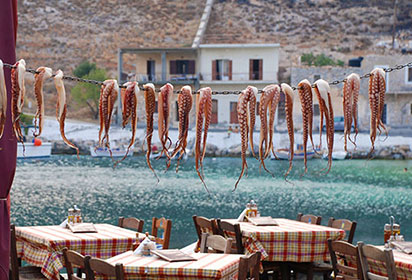Despite belonging to the mainland, the Peloponnese has all the characteristics of the Greek islands: sun, sand, and whitewashed buildings.
Andrew Bostock, author of Greece: The Peloponnese: the Bradt Guide
The Peloponnese is the birthplace of many a legend. Home to such fabled sites as Olympia and Mycenae, here you can wander through classical temples, explore medieval fortresses and walk in the footsteps of Greek gods and heroes.
If you want white-sand beaches lapped by azure water or sleepy, whitewashed villages, then the Peloponnese has them, but it also has much else.
This includes towering mountains in which you can hike and even ski; some of the world’s most famous classical remains, such as the theatre at Epidavros, as well as countless ‘minor’ sites, where you might find yourself alone in the ruins; olive groves that produce the finest fruit and oil in the world; castles and monasteries from several different civilisations; wildflower-swathed hills; villages that vary from modern farming communities to stone-built mountain retreats; inland gorges with whitewater rivers running down them; and the intensely colourful village life, from traditional paneyiri (local festivals) to the hospitality practised in tavernas up and down the region… the list could go on and on.
For more information, check out our guide to The Peloponnese:
Food and drink in The Peloponnese
Food
Greek cuisine is pretty well known nowadays, although the British perception of it is somewhat coloured by the fact that most of the ‘Greek’ restaurants in the UK are in fact Cypriot. The cooking is pretty similar, but two of the mainstays of Cypriot eating, hummus (chickpea dip) and haloumi (grilled cheese), are rare in the Peloponnese – although the former is becoming more common, mainly because visitors are asking for it, and the latter has a cousin in the commonly found saganaki (fried cheese).
The Mediterranean diet is now known to be one of the healthiest in the world. There’s no real secret to it: plentiful olive oil is combined with fresh, local products. Greek cooking, and most of what is on offer in Greek supermarkets, is still very seasonal and this is vital (as we are starting to relearn in other countries). The ultimate proof of this is the so-called ‘Greek salad’. Again, it’s not complicated – just simple, fresh ingredients put together. But compare one made with shipped supermarket ingredients in the middle of a UK winter, with one from the most basic of village tavernas in the Peloponnese. There is simply no comparison. It is no exaggeration to say that first-time visitors are known to go into a stunned ecstasy the first time they bite into a local tomato.
On the other hand, one reasonably legitimate complaint made against eating out in the Peloponnese is that the food can be monotonous. Every taverna seems to have the same menu and serve the same dishes. Part of this is due to the nature of the menus themselves. They are often speculative affairs, listing all the dishes that the taverna might one day serve, rather than what they have on offer right now.
However, it is true that the once clear distinctions between the types of Greek restaurant are being broken down. Once, grill houses pretty much only served meat, fish tavernas only fish, tavernas only oven dishes, and ouzeries just served meze. Now they mostly all seem to do a little bit of everything and come under the general title of tavernas.
Every restaurant of any worth, however, will have its specialities, be it a particular dish that they are known to do well, or an oven dish that they have just cooked up for that day. The trick to getting these is to ask. As always it is worth learning from the Greeks themselves – they rarely glance at the menu, instead engaging the waiter in a long, and sometimes passionate, conversation about what is good today, what dishes go especially well together, and so on. Try doing the same: waiters normally have some English, and if not it is perfectly fine to go and explore the kitchen and point.
Drink
Water is the king among Greek drinks. Each village extols the virtue of their local spring, and people will travel long distances to fill up bottles from a particularly renowned one. The old men boast that they can taste a glass and tell you where in the Peloponnese it came from.
Not so long ago, the Peloponnese was the despair of coffee lovers, but that has changed in recent years. Old-fashioned ‘Greek’ coffee is in fact Turkish, but you’d be wise not to point this out. It is made by boiling the coffee grounds and sugar in the water, and is served in tiny cups with no milk. Old men can make these last for hours. Like all coffee in the Peloponnese it comes either glyko (very sweet), metrio (medium sweet), or sketo (no sugar); opting for the last is considered a little bit odd.
Greeks normally only drink alcohol whilst eating. Up to very recently you couldn’t even order a beer without getting something to eat with it (if only some nuts or cut-up cucumber). Even today the only time Greeks will generally drink without accompanying food is late at night in a bar or club. Extreme public drunkenness is still considered shameful.
The Greeks drink a remarkable amount of whiskey for some reason, but the best-known local spirit is ouzo, a clear, anise-flavoured spirit that turns white with the addition of water. It never seems to transfer well to other countries, but seems to go down well in Greece itself.
Greek wine was long a matter of some amusement, but this has now changed (at least for those in the know); after all, Greece is one of the first places to have cultivated the vine, and the Peloponnese is at the heart of this. There are now some excellent wines to be had, and top Greek restaurants can keep fantastic cellars without recourse to any foreign wines at all. A good bottle of wine is comparatively expensive, starting at around €15 and upwards, but can be very good value for its quality. ‘House’ wine in the Peloponnese is an entirely different question. This is generally very inexpensive and served by the kilo in jugs (a meso kilo, ‘half kilo’, is half a litre and good for two people – at least for starters). It normally comes from large boxes these days, but sometimes is more local, and barrelled.
Health and safety in The Peloponnese
Health
Greece is no longer the back of beyond, and the health issues you will face here are little different from those of most Western countries. There are no inoculations needed for entry, although it’s always wise to be up to date on your tetanus, which these days comes combined with diphtheria and polio. EU citizens are entitled to a certain level of free medical care (apply for an EHIC card before travelling), although proper health insurance is always advisable. Also be aware that ‘free’ health care in Greece doesn’t cover all you might expect, especially in these days of austerity. There are charges, generally small, for prescriptions, tests and, increasingly, even just check-ups. If you need hospitalisation note that nursing care tends to be minimal (Greek families provide this for hospital patients, along with food).
Prescription medicines are widely available, but you would be advised to bring along enough for your trip, along with your prescription itself. Codeine is considered a narcotic in Greece and should be covered by a prescription. However, try not to take codeine-based medicines with you unless there is no other option. Carry a letter from your doctor too.
Pharmacists used to be the first port of call for the ill in Greece. They are well trained and able to prescribe an extensive amount of medication. This is still mostly the case and pharmacies are the best place to deal with most medical issues. In some touristy areas, however, they are getting more cagey, doubtless fearful of being sued, and are more likely to refer you to a doctor.
Most areas are served by a health centre, which is generally staffed around the clock and open for drop-in enquiries in the morning from 08.00. It’s first come first served, so get there as early as possible. These places used to check you out for free, as did hospital casualty wards, but due to the economic situation there are, increasingly, small costs even for this. If you think you have been charged inappropriately then hang on to receipts.
Travel clinics and health information
A full list of current travel clinic websites worldwide is available on www.istm.org. For other journey preparation information, consult www.travelhealthpro.org.uk (UK) or http://wwwnc.cdc.gov/travel/ (US). Information about various medications may be found on www.netdoctor.co.uk/travel. All advice found online should be used in conjunction with expert advice received prior to or during travel.
Safety
Although you would be unwise to leave your house or car unlocked, as you could do 20 years ago, crime is still relatively rare.
Political unrest is increasingly an issue, but this is generally confined to Athens. The Peloponnese has seen only minor protests. If you encounter anything of this sort your best advice is simply to remove yourself from the area.
Woman travellers, especially on their own, might find some male attention unwelcome, although this is much rarer than it once was. Nowadays it is generally confined to some staring, and Greek women will generally be quick to help you if you need to enlist their support.
If you have mobility problems then the Peloponnese is a difficult prospect, and most of its best attractions will only be appreciated with some considerable assistance. Things are getting better, however, thanks in part to the impetus of the Olympics, and Paralympics, in 2004. More recent hotels and restaurants, especially those that have benefited from government money, have started to provide some facilities. You are best advised to contact places directly and ask exactly what kind of access they provide.
Greeks love kids, sometimes to an over-indulgent degree. It is still a place where old ladies and men will give sweets to children they meet in the street. This can seem odd for those of us brought up in more suspicious places, but is also a pleasant change. Almost all restaurants and places to stay will go out of their way to accommodate the needs of your children. This can sometimes be a bit makeshift; if highchairs are not available, normal chairs might be stacked until they are the requisite height, but it is always done with goodwill.
Playgrounds can be found in all Greek towns and many villages. Some of these are modern and well maintained, but many leave a bit to be desired. A good tip is that Greek kids, and their families, tend to gather in the main square, or near the church, of any community to socialise and play. The main time for this is towards dusk, especially in the hot summer months. Greek children tend to be as welcoming as their parents to foreigners, and will generally be delighted to practise their English.
Forest fires are a normal part of the Greek summer, and you should be aware of the dangers of starting one. In the countryside, dispose of cigarettes and glass carefully. The need to evacuate an area due to fires is fairly rare, but you should keep in mind that it is a possibility (a few villages in the Peloponnese suffered this fate in 2015, but the fires did little damage in the end).
Minor earthquakes are not uncommon, and the locals hardly bat an eyelid at them. Larger ones are rarer and all Greek buildings are built to withstand them. If you do find yourself in a big one then go outside into an open area, if you can do so quickly and safely. If not, get under the sturdiest piece of furniture available.
Travel and visas in The Peloponnese
Visas
UK visitors must have a passport. Schengen area visitors face no entry restrictions, but should have a valid passport (this, or a photo driving licence, are supposed to be carried at all times, but you will rarely be called out on this). Most non-EU visitors (including those from the US, Canada, Australia and New Zealand) can stay a maximum of 90 days in Greece and other Schengen-zone countries (most of the EU, but not the UK). Your passport may not be checked if arriving from another EU country, but you need to have it stamped to avoid problems leaving the country. After the UK leaves the European Union, documentation requirements for UK citizens may change. Check before travelling. If you want to stay longer you are best to contact a Greek embassy before you make your trip.
Getting there and away
By air
The Peloponnese has only two ‘main’ airports at the present time, Kalamata and Araxos (near Patra), which used to cater mainly to charter flights, and these are still available in the high season. It is worth noting that both these airports have minimal facilities and you would be wise to organise your onward transport in advance. Flights to the Greek capital, Athens, are a good alternative. It is only an hour by road from the Peloponnese and there are reasonable bus and train connections. Kalamata also has internal flights daily to and from Thessaloniki (in northern Greece – see www.olympicair.com).
By car
If you are planning to be in Greece for any length of time it is perfectly possible to bring your car over from the UK. You are allowed it in the country for six months (keep hold of your ferry ticket to prove when you came in). Although this is rarely checked, if you are caught out your car will be immediately impounded and the fine to release it can be more than it is worth. Driving a UK car on the right-hand side of the road is not as difficult as everyone seems to think it is.
By ferry
Several companies run daily ferries from Italy to Patra in the northeast of the Peloponnese, usually via Corfu. They leave from Venice, Ancona, Bari and Brindisi, with the crossing times getting progressively shorter (from Venice they can be as long as 35 hours, from Brindisi as short as 14 hours). The longer ferry journeys are more expensive, but this is somewhat offset by the price of driving further down Italy. You are always best to book in advance (which you can do via www.directferries.co.uk, www.ferries.gr or www.aferry.com).
There are various forms of accommodation aboard, and these can raise the price quite considerably. It is worth knowing that ‘deck’ class does not mean you are confined outside! You are allowed in the communal areas inside, and in the low season will often find a spot to stretch out and sleep. In the high season you are likely to be obliged to sleep out on the deck, although there are usually plenty of sheltered areas (a sleeping mat or even a pop-up tent is an advantage). A new option for those with camper vans is the ability to stay in them overnight.
You can also get local ferries from Piraeus, the port of Athens, to various ports along the east and south coast of the Peloponnese.
Getting around
By train
Trains are the cheapest form of public transport in Greece, mainly because they are so bad. The exception is the good connection from Athens and its airport to Corinth. Rail buffs should not despair as the short but spectacular rack-and-pinion railway line up to Kalavryta is one of the best rides in Europe.
By bus
Buses are normally fast and efficient, at least on main road routes, and the buses themselves are modern, comfortable and normally air conditioned. Athens to Kalamata is about the longest single bus ride you might want to take. It takes 3½ to 4 hours and costs €23 at present. On intercity routes such as this one you buy a ticket in advance and seating is assigned, although old Greek ladies often don’t understand this. More rural routes are a bit more casual. You buy your ticket from a conductor or the driver on the bus, and the timetable often goes out of the window. You will rarely be alone waiting for a bus, so trust what the locals tell you. If there are only a couple of buses a day they tend to be first thing and in the early afternoon.
By car and motorbike
Unless you want to confine yourself to the major towns and sites, or have a lot of time on your hands, having your own vehicle is by far the best way to explore the Peloponnese. The easiest way to do this would be to hire a car in advance and pick it up at the airport or ferry port. In peak season you can get a small car for around €30 a day. You are always best to get the most comprehensive insurance cover you can.
By taxi
Taxis are much cheaper than in most other European countries. While using them to travel around the whole area would probably be prohibitive, they can be a useful alternative to public transport. In towns they run on the meter (on tariff 1, changing to tariff 2 if they drive out of town). In rural areas there are normally set prices for various journeys. Agree on the charge before starting your journey. A very rough estimate of cost in rural areas would be €1 per kilometre.
Cycling
Despite its high mountains many people enjoy cycling around the Peloponnese, although high summer should be avoided. Many of the resorts hire out mountain bikes. Bringing your own bike by aeroplane is often possible as well, but should be discussed in advance with your airline.
Hitching
Hitchhiking is often risky and is not recommended alone. It also seems to have fallen out of favour in much of Greece, so you might not have much luck. The exception is rural areas where it is not uncommon for people to wave down cars to take them to the next village, most often the elderly. If you are driving then picking them up is at your own discretion, but it can be an excellent way to interact a bit.
Walking
Walking and hiking are the best ways to explore the natural landscape of the Peloponnese. Even a short wander into the olive groves can be a delight. Good trainers or lightweight walking boots are normally sufficient. Lightweight but sturdy long trousers are recommended in spring, when the grass and thorns are high. Walking alone in the mountains is always a risk – make sure someone (perhaps your hotel owner) is aware of your intentions and knows roughly when to expect you back. A mobile phone can also be a good idea as coverage can be surprisingly extensive.
When to visit The Peloponnese
Spring is one of the best times to come to the Peloponnese.The climate can be very pleasant and, although the Greeks will think you mad, you can swim from April onwards. Greek Easter is the biggest festival of the year and it’s usually possible to get involved. Above all, the mountainsides, bare and forbidding for the rest of the year, are covered with swathes of wild flowers in every colour imaginable.
Summer is for the sun worshippers. Temperatures in July and August can soar above 40°C, making anything more energetic than walking into the sea a daunting prospect. It is also the busiest time of year, and not only with foreigners. In August the entirety of Athens decamps to the beaches and accommodation can be hard to come by.
Things start to calm down again in autumn from September onwards. The sea stays warm and swimming remains pleasant into October, which marks the end of the usual ‘holiday season’ that began in April. Don’t discount coming in the winter months, however. There are often sunny and enjoyable days, even in December, and there’s also the opportunity to ski in the mountains.
What to see and do in The Peloponnese
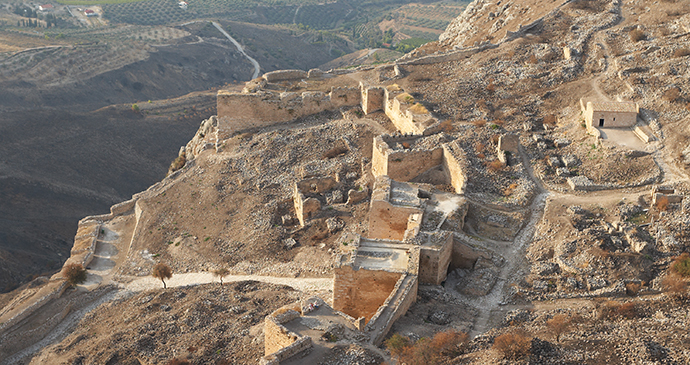
Acrocorinth
Despite its spectacular position and looming presence many people visiting the Peloponnese give Acrocorinth a miss. This is partly because, without your own car, it is only reachable by taxi or an hour-long uphill walk. On top of this it is an extremely large site – water, good shoes and a sun hat are a must. It is worth every effort, however, with its extensive castle ruins and astounding views.
The site is reached by following the road up past the entrance to the ancient city. On your way up you will see the small castle of Pendeskoufi on a nearby peak. It was built by the Franks during their siege of Acrocorinth in the 13th century.
The road ends in a small car park by a modern café, below the imposing walls and gateways of the castle itself. Crossing a dry moat you come to the first of three gateways; a triple fortification whose history mirrors that of the various owners of the castle. The first gateway is mostly Turkish in origin, while the second is a Venetian restoration of an originally Frankish structure. The third, and perhaps most impressive, gateway is mainly Byzantine, but look closely at the large stones in the tower to the right; these probably date back to the 4th century BC.
Inside the castle most of the ruined buildings are Turkish, including a mosque with most of its dome still intact. Three paths snake away from the entrance, although they all end up in the same place. If you are in a hurry the path to the right is the quickest. Almost opposite the gateways, close to the eastern walls of the castle, the main path splits into three again. The path to the right leads to the southern walls and a Frankish tower that you can scramble around for views into the mountains beyond Corinth.
The central path leads around to the left, skirting the walls, before it reaches the upper Fountain of Peirene; look out for fencing around a concrete roof that covers the underground spring. This is where the winged horse, Pegasus, liked to come to drink. Metal steps lead down to stone steps that descend into a twin-arched pool with eerily blue water (not drinkable). The spring has never been known to run dry, a fact the local flies take full advantage of. The path that continues past the spring soon peters out.
The third path goes off to the left, climbing through the centre of the castle to the higher of its two peaks (575m), close to the northern walls. This was the site of the Temple of Aphrodite, although all trace of this has now gone. In ancient times the goddess of love was worshipped with religious prostitution provided by 1,000 sacred courtesans.
Visitors nowadays have to make do with the view. This is no hardship, as even on a hazy day it is impressive; on a clear day you can see from the Acropolis in Athens on the right, to the mouth of the Gulf of Corinth on the left.
The ruins of Messene are more extensive than both Olympia and Old Corinth © elgreko, Shutterstock
Ancient Messene
Ancient Messene is simply astounding, especially as it comes as such a surprise. Most people have heard of Olympia, and many know of the theatre at Epidavros and the ruins of Old Corinth. Messene rarely gets mentioned in the same breath as these great classical sites, but its remains are more extensive than any of them. What makes the site so incredible is that this is no mere religious sanctuary, but an entire city; from its towering walls, theatre, fountains, marketplace, religious centre, and stadium to the tombs of its prominent citizens.
So why is it so little known? There are a couple of reasons. Firstly it is a little off the beaten track – too far south for the Athens’ coach tours and not near enough to any prominent road. Secondly, this is a site that has only recently come into its own. Modern archaeological and restoration work has meant that the site has revealed more of itself with every passing year. More visitors are steadily being attracted to this out-of-the-way spot, but on most days of the year you might well find yourself alone with the ruins – a magical experience.
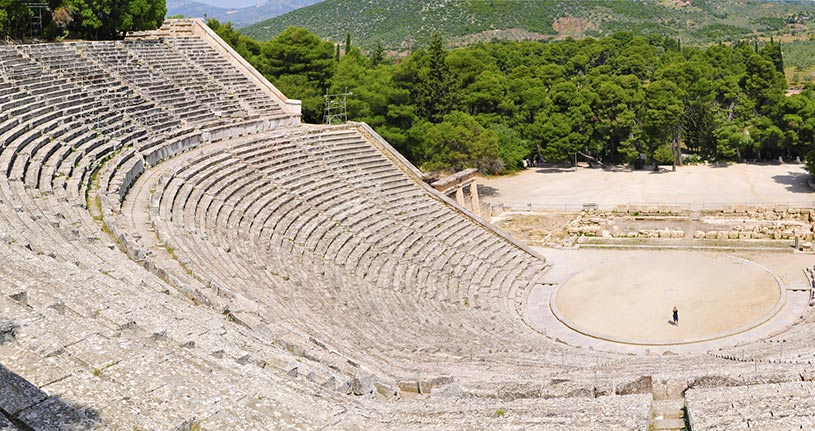
Epidavros
Epidavros is one of the most visited sites in the Peloponnese and is most famous for its theatre, one of the best surviving buildings from the classical period. The theatre, and its surrounding sanctuary, are actually a little bit inland from the ancient city, as well as the two modern settlements that bear its name. It can be a bit confusing, so make sure you know which one you are heading for.
Nea Epidavros (New Epidavros) is the more modern, and is split into two bits: one section on the coast and another above it in the hills. Some 8km to the south, and also on the coast, is Archea Epidavros (Old or Ancient Epidavros) where the ruins of the old city can be found (mostly beneath the sea).
To round things off, Archea Epidavros is often referred to as Paleo Epidavros (which also confusingly translates as Ancient Epidavros). The theatre and sanctuary are separate from either of these and are 10km inland.
During July and August there are weekend performances at the main theatre by Greek and foreign theatre companies.The repertoire has been broadening recently, but the main draw is still the classical plays (done in modern Greek).
Although you may not understand a word there is nothing to compare with the atmosphere of sitting in this ancient theatre, watching the sun dip behind the hills, before the lights come up and you watch the same dramas enacted that were first performed here more than 2,000 years before. It is all but mandatory to book in advance as, although the theatre is huge, parts are currently closed off for renovation, and seats are often booked up months in advance.
In the cheaper seats you will be sitting on the bare stone so a cushion, if you can come by one, is a good idea. There are also performances at the small theatre in Archea Epidavros.
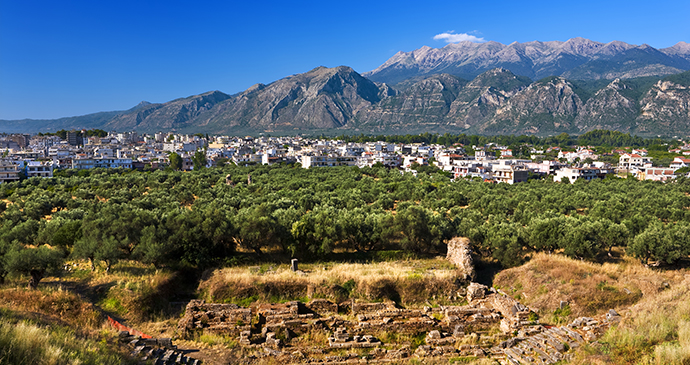
Kardamyli and the Taygetos Mountains
The road north from Stoupa swings downhill, past the village of Proastio with its church with a striking bell tower, and then straight into Kardamyli, the first of two Exo Mani villages that have devoted themselves to tourism (nearby Stoupa being the other). Despite this, and the main road running straight through the middle of it, Kardamyli is delightful, and has one of the most perfect settings of any Greek village, with the towering Taygetos behind – including a rare glimpse of the pyramid-shaped peak of Profitis Ilias, the range’s highest.
The main activity in Kardamyli is enjoying the setting. The village itself is charming and worth a wander about. Its harbour to the south is overlooked by an old fortified custom house. Opposite is the small rocky island of Meropi, where a Venetian castle once stood. The stone chimney in the centre of the village belongs to the ruins of an olive-oil soap factory, once owned by Palmolive. Just to the north of town (take the road down by the church) is the long, pebbly beach of Ritsa, which never seems to feel too crowded.
The village is used by many as a base for hiking in the Taygetos and there are many fantastic walks around, many using the old stone paths that used to link the villages (kalderimi). There are map boards and hiking trails around the village, but if you really want to explore it’s best to invest in some maps and/or walking guides, all of which are available at the bookshop.
If you only have time to do one hike then the walk up to the villages above Kardamyli is the one to go for. A kalderimi leads from the back of the old town along the side of the Viros Gorge. It soon passes the so-called Tombs of the Dioscouri, the alleged burial spot of Castor and Pollux. The two rock-cut tombs are probably Mycenaean in origin.
A half-hour uphill finds you by the church and the outskirts of the village of Agia Sophia, where a path to the right takes you on, crossing a streambed after a while, and then to the outskirts of Petrovouni. The views from here back down to Kardamyli are more than worth the effort so far. Another kalderimi can take you straight back down from here, but it is worth continuing to Proastio. In spring you may well see orchids around here, and the village itself is lovely, stuffed to the gills with interesting churches. It also produces a locally famous rosé wine. A kalderimi leads from here down to Kalamitsi Bay, just to the south of Kardamyli.
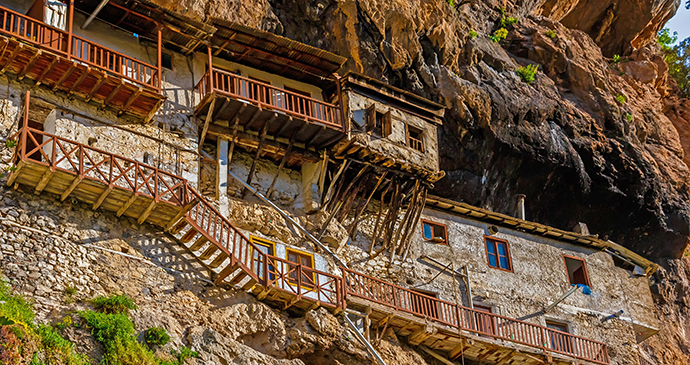
Lousios Gorge
The Lousios is said, by Pausanias, to be where Zeus was bathed as an infant (hence the name, which means ‘Wash’). It is also said to be the coldest river in the world, which on a hot summer day is well worth checking.
Sometimes also known as the Gortys, the Lousios is not a long river, beginning only 26km north of Karitena, near to which it merges with the Alphios. For almost all its length, however, it flows through an impressive gorge, with red limestone cliffs rising to 100m above the tumbling river, which is surrounded by prolific plant life even in the summer. Right up to the 20th century the river’s power was harnessed by countless watermills, whilst the cliffs above provided the home to hermits and monks in caves and cliff-hugging monasteries, the latter of which are still inhabited. The gorge is becoming more accessible as the various dirt roads to its attractions are asphalted, but most of it is still only reachable by paths. Walking along these, with the clear waters of the river running beside you, it is easy to see what an Arcadian idyll really is.
Above the gorge are the two villages of Stemnitsa and Dimitsana, which are perhaps the most beautiful of all the Arcadian mountain settlements. Not so long ago these were rustic backwaters with basic, if any, accommodation. Now they have become trendy weekend getaways for Athenians, but with strictly enforced preservation orders they have lost none of their charm.
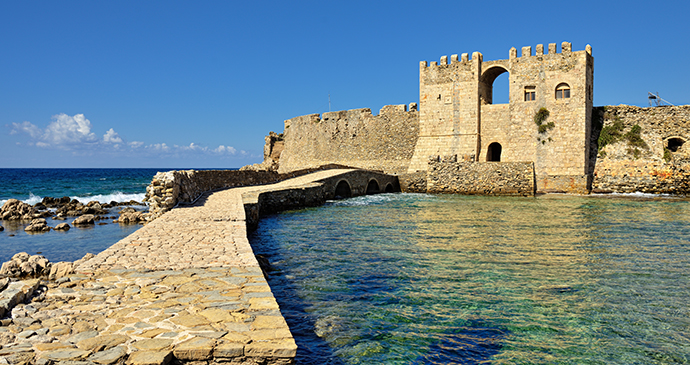
Methoni Castle
While the warlike nature of the castle at Koroni seems to have been mitigated by its vegetable gardens and nunnery, there is no escaping the intent of this castle. There has been a fortification here since ancient times. A German dynamite explosion in 1944 revealed Mycenaean foundations.
You enter the castle over an elegant, 14-arched, stone bridge, built by the French in 1828 to replace an earlier wooden one. The inland-facing walls, unsurprisingly, are the most impregnable part of the fortifications. The bridge crosses a large moat started by the Venetians with the original intention of flooding it with sea water, thus entirely surrounding the castle. Their work was interrupted by the Turkish attack of 1500.
On either side of the bridge are artillery bastions; the one on the right built under the command of the Venetian governor Giovanni Bembo in 1460, and the one to the left constructed by Antonio Loredan in 1714. On the walls of this bastion can be seen the Venetian emblem of the Lion of St Mark. It is easy to see how cannon from these bastions would have dominated the castle entrance.
Once over the bridge and through the gate, with its carved pillars, a sharp left turn acts as a further defensive measure, and then leads through a further two gates, one of which is pierced by a cannon hole. The second gate leads you into the interior of the castle itself.
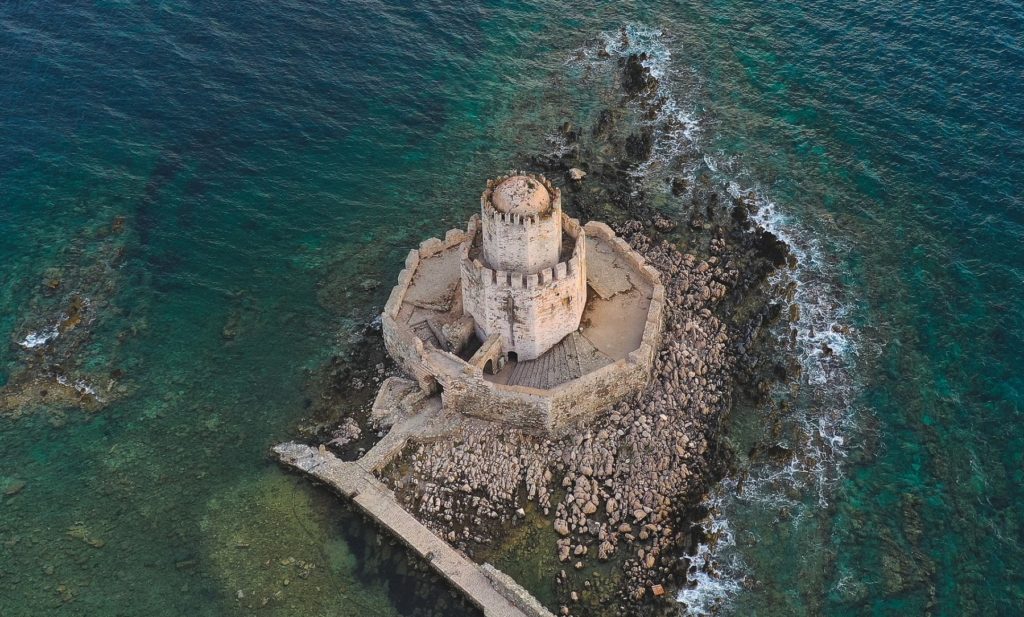
This is where the old town of Methoni was, with a far larger population than in modern times. There are only a handful of buildings remaining now, including a few ruined Turkish baths and a more recent Orthodox church. A granite column right by the gate is of disputed origin, but was probably put up in commemoration of Giovanni Bembo in 1494. The odd pyramid-roofed building opposite the gate was an armoury.
It is worth heading for the southernmost wall of the castle, where a large sea gate is in the process of being restored. From this a causeway leads you to the Bourtzi tower, perched on a rocky islet. This is where the last survivors of the Turkish assault of 1500 were put to the sword. Despite its dark past it is a beautiful and romantic spot.
Back near the granite column the landward wall, with its single gate, separates the ‘habitable’ side of the castle from the defensive part above the twin bastions. This section of the fortress makes for great exploring. Follow the path past the old barracks, and then down a dark tunnel of stairs. You emerge into a series of fortifications and passageways lined with cannon holes. Follow them round until you end up by the entrance gate once again.
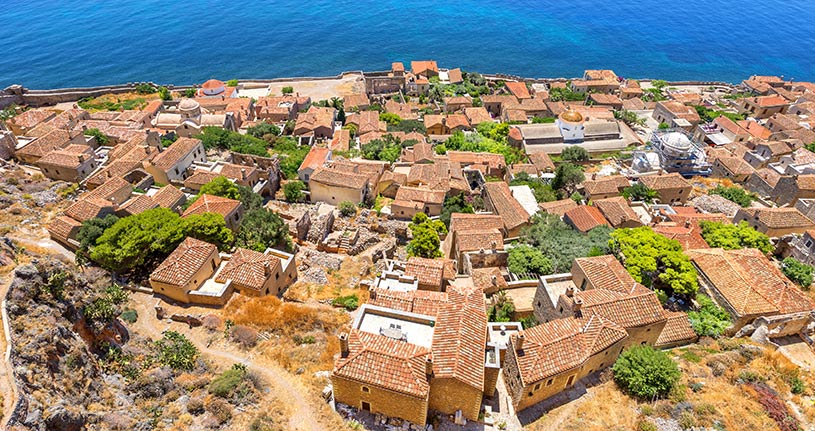
Monemvasia
It’s impossible to avoid the hackneyed comparison between Monemvasia and Gibraltar, and it does bring up an image that is, in large part, accurate. Monemvasia is a great rock that rises up out of the sea, with only a thin connection to the mainland, but it doesn’t convey the place’s main feature, which is an enormous dollop of romance.
Above all Monemvasia is for couples: to wander, hand-in-hand, down the cobbled lanes; to browse the small boutiques in search of art or jewellery; to sip cocktails on terraced platforms above tiled roofs. It is still a place of beauty for those on their own, but if you are in love, you have found your Mecca.
Monemvasia is basically a Byzantine settlement, much like Mystra. The major difference is that it was never abandoned, and people still live here. Anywhere else this would have led to modernisation and the loss of the old town, but Monemvasia had one advantage going for it, and the clue is in the name: it means ‘Single Entrance’.
Like Mystra the town was surrounded by walls, and there is only one gateway that leads through them towards the causeway and the mainland. Crucially it was, and remains, too small for cars. The villagers probably cursed this, and many of them moved to Gefyra, the mainland settlement opposite the rock, but it meant that the old style of the town endured.
For a long while this historical survival was its main interest, but about 20 years ago people started noticing Monemvasia’s other virtue: its breathtaking, heart-stopping, beauty. Fortunately the locals, and others who bought property, realised that they must preserve the nature of the place, and development has been careful and measured. Hotels are in well-restored old buildings, and the town has gained a reputation as an artists’ colony. The atmosphere of the old town has actually benefited from this new lease of life, and as long as nothing bigger than a donkey can get in, it should long continue.
The setting of the ruins of Mystra is breathtaking © Tatiana Popova, Shutterstock
Mystra
Nowhere else does the medieval, and especially the Byzantine, world seem to come alive as it does at Mystra. The setting itself is breathtaking enough. The Chronicle of the Morea, the romanticised account of the Franks in the Peloponnese, calls it a ‘strange hill, as though cleaved from the mountainside’. On this spur of the Taygetos are the ruins of an entire city, the old Byzantine capital of Morea, with its lanes and alleyways, palaces, castle and, above all, churches calling out for exploration. Even on the site’s busiest day it is not hard to find a quiet corner where you can drink in the combination of natural and manmade beauty, and try to commune with the ghosts that walk the streets of this once-great city.
Mystra is a large site, and can be tiring to visit, especially on a hot summer’s day. At the very least you will want to spend a couple of hours here, but ideally you should set aside a half, or even a full day for exploration.
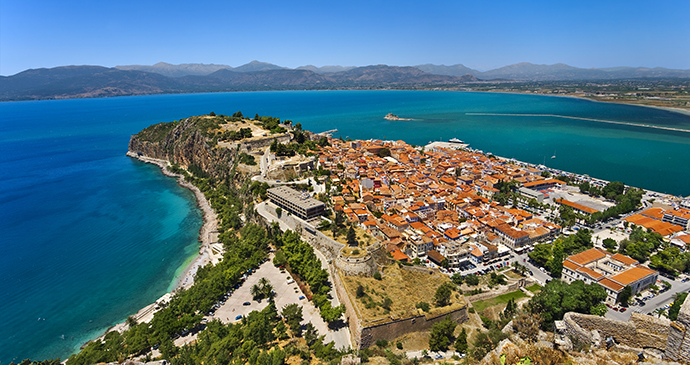
Nafplio
Nafplio is easily the prettiest large town in the Peloponnese, a fact not lost on the nearby Athenians who flock to visit on weekends and holidays – times when you’d be well advised to have a reservation if you want to stay here. It is well worth the effort as Nafplio is a delight, even when thronged with people.
Its faded, Neoclassical elegance has been updated over recent years with a layer of trendy chic (even the branch of the Goody’s fast-food chain looks like a designer bar) and the shops, cafés and restaurants are up to Athenian standards (often with prices to match). This comes hand in hand with a beautiful setting, with the placid harbour set below two dramatic hilltop castles and lapping the shores of a third island-bound one.
The old town is centred on the large, marble-paved Syntagma Square, ringed with cafés. At one end is the old town Arsenal, a handsome building that now houses a museum. At the other end is an old mosque, which now occasionally serves as a cinema. The surrounding streets are lined either with tavernas or shops; shopping is a serious business here, with designer names mixing with local artists and crafts.
The waterfront has lovely views over to Bourtzi Castle. The main harbour road, Bouboulinas, is named after Laskarina Bouboulinas, the famous female sea captain from the War of Independence, and there is a statue of her at its east end.
The castle of Akronafplia looms over the old town. There have been fortifications here going back at least to Classical times. Now it is the preserve of the Nafplia Palace hotel, who try their best to discourage outsiders from disturbing their exclusive guests. Fortunately there’s not much to see, anyway. If you don’t feel like walking up, a free lift connects the central waterfront to the fortifications around the Nafplia Palace hotel.
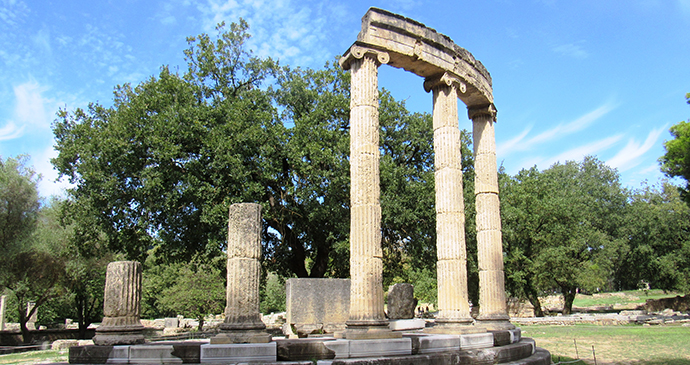
Olympia
Olympia is by far the most famous site in the Peloponnese. Situated in the northwesterly province of Ilia (Ancient Elis), this is where the most important festival of the ancient world took place, in both Greek and Roman times. And it still has a place in modern world culture. It is here, every four years, that the Olympic flame is first lit (by the power of the sun) before being taken to whichever city is hosting the modern games.
Most ancient ruins in Greece seem to be located in fantastically dramatic locations; think of the Temple of Apollo at Vasses to the south, or Mycenae rising up on its crag of rock, or, indeed, the Parthenon itself. Olympia, in contrast, is set in a lush and bucolic valley, watered by the famous Alphios to the south and its tributary, the Kladeos, to the west. The mighty-sounding Mount Kronos (Zeus’s father) which lies just to the north of the site is, in reality, a small hill, barely 100m tall. The white columns of the ruins lay below it, shaded not only by the ubiquitous olive, but also by plane trees, oaks and poplars.
The forest fires of 2007 came close to destroying this idyll, turning the hill of Kronos into a charcoal mound and coming within metres of the ruins themselves. They were saved by the concerted efforts of the locals, whether they worked on the site or not, and now the slopes of Kronos have been replanted. Olympia remains a remarkable place, peaceful and romantic, especially in the spring, when wild flowers surround the ruins.
That said, it can also come as something of a disappointment to many visitors. This is partly due to false expectations. Perhaps people anticipate something on the scale of the modern stadiums that are built to host the Games, or at least something comparable to the Parthenon, or the theatre at Epidavros, rather than the somewhat jumbled, and often confusing, ruins that do remain. There is also no denying that the modern village next to the site, whilst functional, lacks charm or character. On top of this the site itself is often crowded, even first thing in the morning.
Please don’t be discouraged. Olympia is a place that repays the effort you put into it. Away from the coach parks and the tourist facilities, the atmosphere of the place still prevails, giving some idea of why the ancients chose the site in the first place. Even on a busy day you will be able to find a quiet corner to sit and contemplate the place, and on a cloudy, wet day in autumn you might have the ruins to yourself. The Olympic ideal, peace between states fostered by friendly competition, was difficult to achieve even in Classical times, but here, in this Arcadian glade, you can still feel its power.
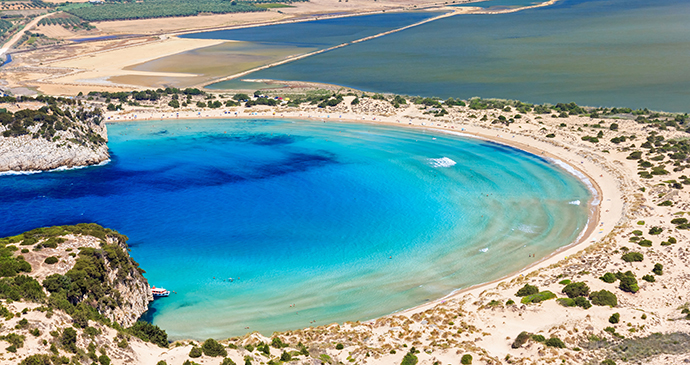
Voidokilia Beach
The best way to explore the area around this superlative beach and dramatic castle is to take a walk around the area. This should be done over a leisurely half to a whole day, including swimming and a picnic.
You will probably have already seen a picture of Voidokilia Beach; it is a common postcard subject. It does look like it has been magically transported here from the Caribbean or the South Seas: a golden crescent of sand lapped by azure waters and backed by the lagoon. Unfortunately it can get quite crowded in the high summer and at weekends. Come here in the spring or autumn, however, and you will likely have this paradise to yourself. The easiest way to get here is to take the left turn (on a sharp right-hand bend) 6km north of Gialova, and then follow the signs past the villages of Romanos and Petrohori.
Above the beach and below the castle can be seen the gaping hole of Nestor’s cave. An obvious path leads up to it through the dunes at the end of Voidokilia. It was supposedly used as a cattle pen by the wise old king.There is plenty of opportunity for diving in the area, both snorkelling and full scuba.
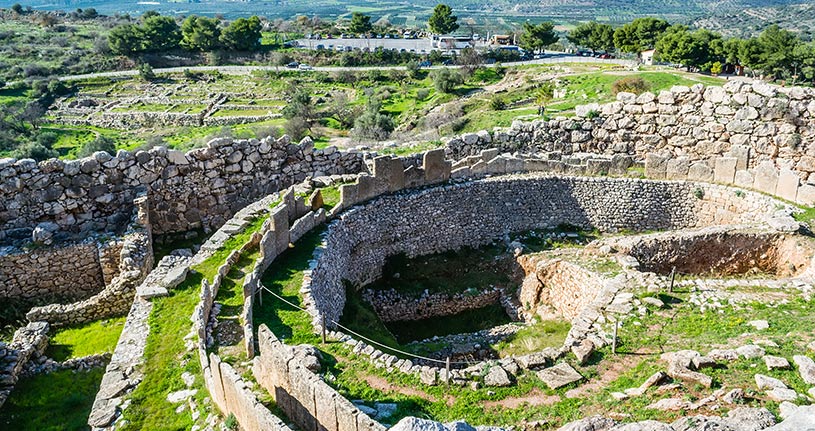
Walls of Ancient Mycenae
The citadel of Agamemnon, celebrated by Homer as ‘rich in gold’, has given its name to an entire civilization. The ruins that it left behind were ancient even in classical times, and already were the subject of myth and legend. Pausanias attributed the great walls of the citadel to the Cyclopes, one-eyed giants. If the white marbled temples and theatres speak of philosophy and high art, then the walls and remains of Mycenae are redolent of something darker: a blood-stained, myth-haunted past.
Most of what remains at Mycenae dates from 1350–1200BC. This includes the walls of the citadel, which are still impressive, fully justifying the adjective ‘Cyclopean’. They are made of lines of gigantic, barely formed blocks of limestone. They vary from 4m high to over 10m, and can be equally as thick, and are quite striking.
Related books
For more information, see our guide to the Peloponnese:
Related articles
From little coastal fishing ports to high mountain settlements, the Peloponnese has it all.
According to Andrew Bostock, Giros pita are the finest fast food in the world.
Our guide to the best places to visit if you want to get off the tourist trail and discover the real the Peloponnese.
